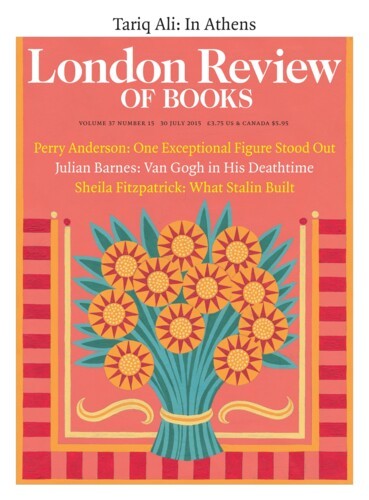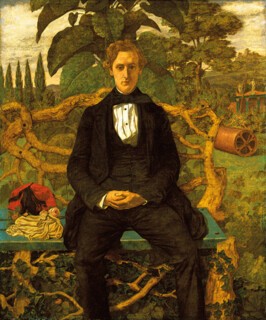Portrait painting requires stillness. What, for the subject, is it like to be still? As far as one can tell, the gentleman facing Richard Dadd in 1853 had nothing that he wished to project: his attire was dapper, his red locks kempt, but his eyes did no more than attend, uninflectedly staring back at those that analysed him. At the same time the painter, adjusting the tonal weights that composed the sitter’s head, arrived at a subtle asymmetry that fractured the psychological monotony, touching some faultline in his subject’s self-possession. He must surely be a fool – this guileless, posh young Londoner, this obverse of Ingres’s Monsieur Bertin – to allow himself to be so immobilised. See how, in his slouch, his figure balloons away from that absurd little apex of a head, his knees distending in proximity to the painter’s. Note how his conical form gets bracketed by giant sunflower leaves and the boughs of a rustic bench, both studio insertions more animated than he is, and how, in a mischievous coup de grâce, a hefty garden-roller with rococo brackets has been hauled onstage to steal the show. An analogue to the sitter’s inertia?
Portrait of a Young Man is extraordinary in its potent passivity; and its assemblage technique too is arresting. Walking around the Tate’s survey of the Pre-Raphaelites three years ago, I wondered whether the paradigm for painting established by Holman Hunt, their ideologue, was the specimen-case: a tray on which samples of physical appearance were assembled. Walking around the fascinating exhibition now at the Watts Gallery in Compton, Surrey (till 1 November), I realise that Dadd, unconnected to Hunt but ten years older, was taking the principle altogether further. A picture by Dadd is a package of information unified by exquisite surface control. (I namecheck Ingres in jest, yet the finesse of Dadd’s mark-making can be quite astonishing.) The information issues from heterogeneous sources: studies from life occasionally, but more often travel sketchbooks, prints, catalogues and pattern books, poetical and historical texts. They come together in quizzical combinations. The foot of a work on paper called Patriotism is occupied by Gillrayesque military caricatures: the upper half by a map; sandwiched between, a near-hundred lines of minute manuscript supply the sheet with ballast. Elsewhere, contemporary vagrants share a mountain range with a medieval knight battling an ancient Roman.
What would it be like if all things always had the status of information? If particles of reported appearance reigned supreme? The postulate, dandled all sorts of ways in the mid-19th century (from literary realism to the scrap screen), was given a singular twist by Dadd. As Nicholas Tromans, the curator at Compton, put it in Richard Dadd: The Artist and the Asylum (2011), Dadd concluded that ‘there was no history to speak of’ and that ancient, medieval and modern rightfully shared the same flat plane. Time being abolished, each phenomenon was frozen in eternity and either giddily full of itself or giddily empty. That is the delirium of the red-haired gentleman, and the condition in which the innumerable cast of The Fairy-Feller’s Master-Stroke is suspended.
Dadd’s most famous canvas presents a vision, among much else, of infinite density. In an ungovernable accretion, like lime-bloom on a wall, tiny globules of paint come together to form leaf-lobes, grains of soil and petals: dark eyes, engorged limbs and laden fabrics; ‘atomies’ both natural and supernatural, all similarly spawned and all dimly glistening, behind a screen of grass-blades, in a lugubriously beautiful blue-grey elsewhere.
‘Atomies’ was a coinage Dadd borrowed from Mercutio’s speech about the fairies in Romeo and Juliet, in a doggerel explanatory note about his nine-year labour on that painting. Atomies might be thought of as the imagination’s smallest divisible units: but what is the imagination? ‘Thou talk’st of nothing,’ Romeo tells Mercutio. Dadd’s poem ends by conceding that possibility. Insubstantiality would be a form of release. The terrifying weight of The Fairy-Feller flips over into an exhilarating vaporisation in two extraordinary watercolours, a fantasia on Gibraltar called Port Stragglin and The Crooked Path, the mountain scene I’ve already mentioned. Its play-actors from the ages of history and its gnarled vertiginous geology fade jointly into the warmth of the paper, ripples with no depth beneath.
These fictions of oppression and liberation have somehow to be imagined in relation to the physical individual producing them, the Royal Academy alumnus of the late 1830s who from his 26th year onwards was a permanently incarcerated ‘criminal lunatic’. Tromans, who two years ago took on the running of that later Victorian fantasia, the Watts Gallery, had earlier published his study of Dadd, thus clearing the conceptual ground for doing so. A debonair literary performance, bringing cool wit to emotive terrain, it advances the case that ‘searching for any measurable madness in Dadd’s art seems unlikely to take us far.’ In thus detaching the work from the retentive grip of pathos and psychiatry, Tromans has to consider the reason Dadd needed to leave the outside world in 1843 – his murder of his father – and the reason behind that act, Dadd’s belief that he was the offspring of Osiris (he had recently returned from Egypt) and that his parent-by-the-register was a devilish impostor.
The system of delusions prompted by Dadd’s psychosis – a family illness, it seems – persisted till his death in Broadmoor aged 68, and clearly informed the decades of industrious studio practice that were granted him by intrigued asylum supervisors. The pictures displayed at the Watts Gallery trouble the mind with pressures hardly to be encountered elsewhere. Yet Tromans is surely right: we can no more reduce this ‘expertly executed’ oeuvre to the effects of some unifying underlying disturbance than we can glimpse in the slouched hospital visitor’s eyes any alarm at the allegedly violent inmate he was confronting. One might alternatively turn and ask: what was the transaction here? A painter with no conceivable public career, a portraitist who would only get paid (according to one account) in apples: what can art history have to do with anything so anomalous? But in this regard, at least, Dadd was as normal as they come: most artists are anomalous. Scribbling in his cell in the margins of a copy of Haydon’s Lectures, the scion of Osiris pronounced perfect good sense: ‘What more slavish than painting, what more hopeless?’
Send Letters To:
The Editor
London Review of Books,
28 Little Russell Street
London, WC1A 2HN
letters@lrb.co.uk
Please include name, address, and a telephone number.


